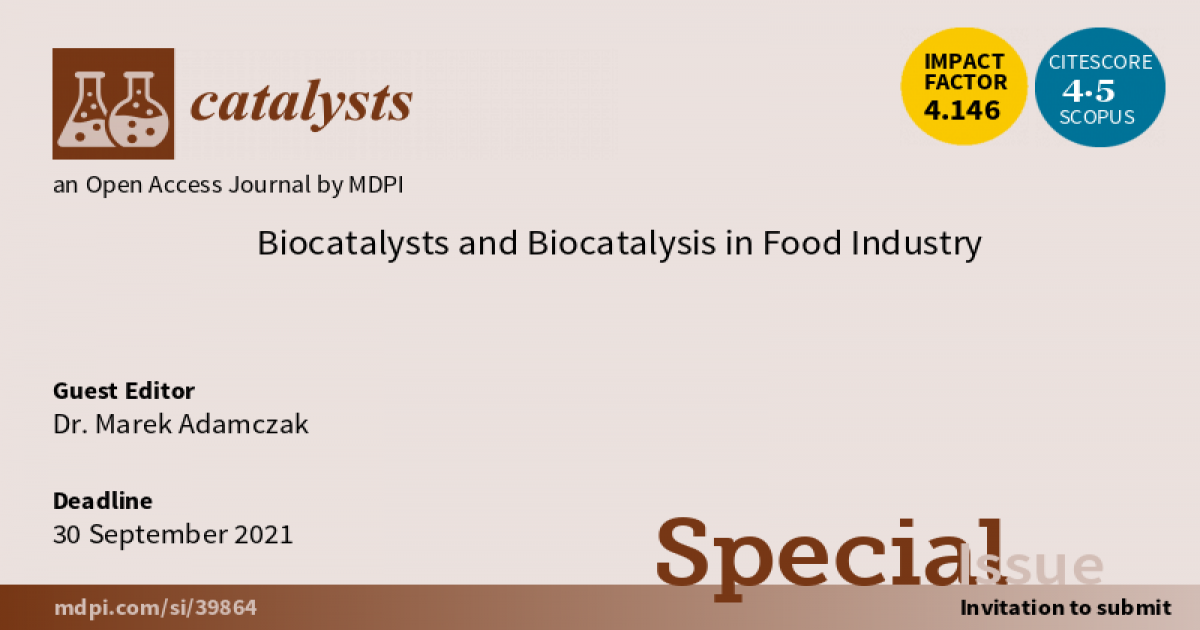Biocatalysts and Biocatalysis in Food Industry
A special issue of Catalysts (ISSN 2073-4344). This special issue belongs to the section "Biocatalysis".
Deadline for manuscript submissions: closed (30 September 2021) | Viewed by 21305

Special Issue Editor
Interests: food enzymes; biocatalysis; medium engineering; food compounds modification; enzyme inhibition; lignocellulose hydrolysis; fermentation
Special Issues, Collections and Topics in MDPI journals
Special Issue Information
Dear Colleagues,
There are about 7800 enzymes classified in the BRENDA database, and a few thousand described in the literature. Enzymes and whole-cell catalysts, active under mild conditions, are traditionally used in food production. The application of enzymes in the food industry ensures the production of high-quality products, food safety and security, and the production of functional food. It also preserves products; increases nutritive values; and improves the taste, flavor, and texture of the food. Enzymes in the food industry play an important role as food processing aids, and in the valorization of waste- and by-products. New enzymes are required for specific applications, and available enzymes need to be improved by using a new toolbox, that is, protein engineering and molecular biology techniques and mutagenesis. Traditional methods of medium engineering are also used (e.g., immobilization). A paradigm shift in designing biocatalytic processes has been observed, and tailoring enzymes to the processing conditions is required.
This Special Issue collects original research papers, reviews, and opinions focused on the biocatalysts and biocatalysis in the food industry. Submissions are also welcome from outside the areas presented above.
Dr. Marek AdamczakGuest Editor
Manuscript Submission Information
Manuscripts should be submitted online at www.mdpi.com by registering and logging in to this website. Once you are registered, click here to go to the submission form. Manuscripts can be submitted until the deadline. All submissions that pass pre-check are peer-reviewed. Accepted papers will be published continuously in the journal (as soon as accepted) and will be listed together on the special issue website. Research articles, review articles as well as short communications are invited. For planned papers, a title and short abstract (about 100 words) can be sent to the Editorial Office for announcement on this website.
Submitted manuscripts should not have been published previously, nor be under consideration for publication elsewhere (except conference proceedings papers). All manuscripts are thoroughly refereed through a single-blind peer-review process. A guide for authors and other relevant information for submission of manuscripts is available on the Instructions for Authors page. Catalysts is an international peer-reviewed open access monthly journal published by MDPI.
Please visit the Instructions for Authors page before submitting a manuscript. The Article Processing Charge (APC) for publication in this open access journal is 2700 CHF (Swiss Francs). Submitted papers should be well formatted and use good English. Authors may use MDPI's English editing service prior to publication or during author revisions.
Keywords
- Enzyme
- Biocatalysis
- Food industry
- Immobilized enzymes
- Structured food compounds
- Modification of food compounds
- Waste- and by-product valorization
- Enzyme synthesis
- Enzyme modification
- Metagenome
- Directed evolution
- Adaptive laboratory evolution





